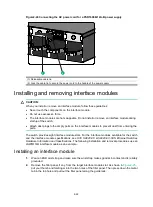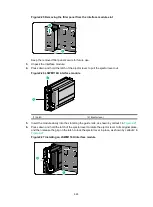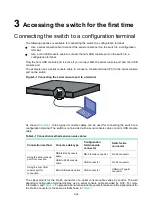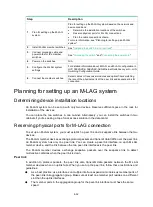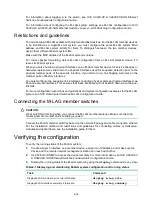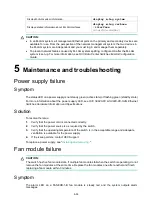
4-32
Step
Description
1.
Plan for setting up the M-LAG
system.
Plan for setting up the M-LAG system based on the network and
device conditions:
•
Determine the installation locations of the switches.
•
Reserve physical ports for M-LAG connections.
•
Plan the cable connection scheme.
For more information, see "Planning for setting up an M-LAG
system."
2.
Install M-LAG member switches.
See "
Installing the switch in a 19-inch rack
3.
Connect grounding cable and
power cords for the member
switches.
See "
4.
Power on the switches.
N/A
5.
Configure the M-LAG system
settings.
For detailed information about M-LAG, see M-LAG configuration in
H3C S9820-8C & S9820-8C-SAN Ethernet Switches Layer 2—LAN
Switching Configuration Guide
.
6.
Connect the member switches.
Select cables or transceiver modules and optical fibers matching
the rate of the physical ports of the peer link and keepalive link for
connection.
Planning for setting up an M-LAG system
Determining device installation locations
An M-LAG system can be set up with only two devices. Reserve sufficient space in the rack for
installation of the devices.
You can place the two switches in one cabinet. Alternatively, you can install the switches in two
cabinets if you're seeking a top-of-rack access solution in the data center.
Reserving physical ports for M-LAG connection
To set up an M-LAG system, you must establish a peer link and a keepalive link between the two
devices.
The M-LAG member devices exchange protocol packets and transmit data traffic over the peer link.
An M-LAG system has only one peer link. You can create a peer-link interface on each M-LAG
member device, and the link between the two peer-link interfaces is the peer link.
The M-LAG member devices exchange keepalive packets over the keepalive link to detect
multi-active collisions when the peer link is down.
Peer link
In addition to protocol packets, the peer link also transmits data packets between the M-LAG
member devices when an uplink fails. When you set up the peer link, follow these restrictions and
guidelines:
•
As a best practice, use interfaces on multiple interface expansion modules as member ports of
the peer-link link aggregation group. Make sure at least one member port resides on a different
slot than the uplink interfaces.
•
The member ports in the aggregation group for the peer-link interface must have the same
speed.
Summary of Contents for S9820-8C-SAN
Page 37: ...3 30...





